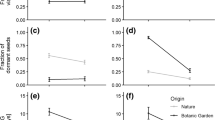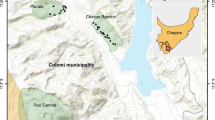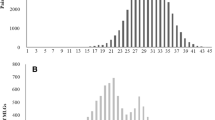Abstract
Clonal propagation and sexual reproduction have diametrically opposite effects on the genetic diversity of crops, permitting, respectively, the conservation of existing genotypes or the creation of new diversity. Oxalis tuberosa Mol. (“oca”) exhibits a heteromorphic self-incompatibility system and is traditionally propagated clonally but is capable of sexual reproduction. In this study we investigated the influence of sexual reproduction on the in situ genetic diversity of a vegetatively propagated crop, taking oca as a model plant. The occurrence of sexual reproduction in natural conditions and its use by farmers were studied through surveys and interviews, while the effect of sexual reproduction on the in situ genetic diversity was evaluated using microsatellite analysis. Plantlets issuing from sexual reproduction were encountered in five of the nine visited communities. The interviews indicated that six out of the nine interviewed farmers were likely, albeit unconsciously, incorporating clonal lineages issuing from sexual reproduction into their varieties. The microsatellite analysis indicated a strong effect of such incorporations on the genetic diversity of the plant varieties. Assignment tests confirmed the allogamy of oca. “Complex varieties”, made up of individuals exhibiting genetically differentiated genotypes, were most likely the result of recent crossing. Unconscious incorporation of new genotypes into the cultivated oca germplasm is therefore highly likely, raising the question of its potential occurrence in other vegetatively propagated crops. These findings could have an important effect on the adaptive potential of oca, especially in light of the genetic erosion that threatens the crop.














Similar content being viewed by others
References
Academia mayor de la lengua quechua (2005) Diccionario quechua-español-quechua. Gobierno regional de Cusco, Cusco, p 479
Alandia BS (1967) Producción de semilla sexual en oca. Sayana (Bolivia) 2:12–15
Arbizu C, Tapia M (1992) Tubérculos andinos. In: Hernández Bermajo JE, León S (eds) Cultivos marginados: otra perspectiva de 1492. FAO, Rome, pp 147–161
Arnaud-Haond S, Duarte CM, Alberto F, Serrão EA (2007) Standardizing methods to adress clonality in population studies. Mol Ecol 16:5115–5139
Barrett S (1993) The evolutionary biology of tristyly. In: Futuyma D, Antonovics J (eds) Oxford surveys in evolutionary biology, vol 9. Oxford University Press, Oxford, pp 283–326
Barrett S, Shore J (2008) New insights on heterostyly: comparative biology, ecology and genetics. In: Franklin-Tong VE (ed) Self-incompatibility in flowering plants—evolution, diversity, and mechanisms. Springer, Berlin, pp 4–32
Bianco M, Sachs C (1998) Growing oca, ulluco, and mashua in the Andes: socioeconomic differences in cropping practices. Agric Hum Values 15:267–280
Blair MW, Panaud O, McCouch SR (1999) Inter-simple sequence repeat (ISSR) amplification for analysis of microsatellite motif frequency and fingerprinting in rice (Oryza sativa L.). Theor Appl Genet 98:780–792
Bornet B, Goraguer F, Joly G, Branchard M (2002) Genetic diversity in European and Argentinian cultivated potatoes (Solanum tuberosum subsp. tuberosum) detected by inter simple sequence repeats (ISSRs). Genome 45:481–484
Bradbury EJ, Emswhiller E (2011) The role of organic acids in the domestication of Oxalis tuberosa: a new model for studying domestication resulting in opposing crop phenotypes. Econ Bot 65:76–84
Bulmer R (1965) Beliefs concerning the propagation of new varieties of sweet potato in two New Guinea Highlands societies. J Polyn Soc 74:237–239
Carrión S, Hermann M, Trognitz B (1995) La biología reproductiva de la oca (Oxalis tuberosa Molina). Boletín de Lima 98:48–68
Cordeiro GM, Pan YB, Henry RJ (2003) Sugarcane microsatellites for the assessment of genetic diversity in sugarcane germplasm. Plant Scie 165:181–189
De Azkue D, Martínez A (1990) Chromosome number of the Oxalis tuberosa alliance (Oxalidaceae). Plant Syst Evol 169:25–29
Doyle JJ, Doyle JL (1987) A rapid DNA isolation procedure for small quantities of fresh leaf tissue. Phytochem Bull 19:11–15
Earl DA, vonHoldt BM (2012) STRUCTURE HARVESTER: a website and program for visualizing STRUCTURE output and implementing the Evanno method. Conserv Genet Resour 4:359–361
Elias M, Penet L, Vindry P, McKey D, Panaud O, Robert T (2001a) Unmanaged sexual reproduction and the dynamics of genetic diversity of a vegetatively propagated crop plant, cassava (Manihot esculenta Crantz), in a traditional farming system. Mol Ecol 10:1895–1907
Elias M, McKey D, Panaud O, Anstett MC, Robert T (2001b) Traditional management of cassava morphological and genetic diversity by the Makushi Amerindians (Guyana, South America): perspectives for on-farm conservation of crop genetic resources. Euphytica 120:143–157
Emshwiller E (2002) Ploidy levels among species in the ‘Oxalis tuberosa alliance’ as inferred by flow cytometry. Ann Bot 89:741–753
Emshwiller E (2006) Origins of polyploid crops. The example of the octoploid tuber crop Oxalis tuberosa. In: Zeder MA, Bradley DG, Emshwiller E, Smith BD (eds) Documenting, domestication new genetic and archaeological paradigms. University of California press, Berkeley, pp 153–168
Evanno G, Regnaut S, Goudet J (2005) Detecting the number of clusters of individuals using the software STRUCTURE: a simulation study. Mol Ecol 14:2611–2620
Falush D, Stephens M, Pritchard JK (2003) Inference of population structure using multilocus genotype data: linked loci and correlated allele frequencies. Genet 164:1567–1587
Gibbs PE (1976) Studies on the breeding system of Oxalis tuberosa Mol. Flora 165:129–138
Guaraguara KJ (2013) Establecimiento de un kit de microsatelites en oca (Oxalis tuberosa Molina) para estudios de diversidad genética. M. Sc. Thesis. Universidad Mayor de San Simón, Cochabamba, Bolivia, 133 p
Hennig C, Hausdorf B (2010) Prabclus: functions for clustering of presence-absence, abundance and multilocus genetic data. R package version 2.2-2. URL: http://CRAN.Rproject.org/package=prabclus
Huamán Z (2001) Semilleros communales de papas nativas del Perú. Biodiversidad 30:20–22
Hubisz M, Falush D, Stephens M, Pritchard J (2009) Inferring weak population structure with the assistance of sample group information. Mol Ecol Resour 9:1322–1332
Husson F, Le S, Pages J (2010) Exploratory multivariate analysis by example using R. Chapman and Hall/CRC, London, p 240
Jaccard P (1908) Nouvelles recherches sur la distribution florale. Bull Soc Vaudoise de Sciences Naturelles 44:223–270
Jarvis DI, Myer L, Klemick H, Guarino L, Smale M, Brown AHD, Sadiki M, Sthapit B, Hodgkin T (2000) A training guide for in situ conservation on farm. International Plant Genetic Resources Institute (IPGRI), Rome, Italy 161 p
Johns T, Keen SL (1986) Ongoing evolution of the potato on the altiplano of Western Bolivia. Econ Bot 40:409–424
King SR, Gershoff SN (1987) Nutritional evaluation of three underexploited Andean tubers: Oxalis tuberosa Oxalidaceae, Ullucus tuberosus Basellaceae, and Tropaeolum tuberosum Tropaeolaceae. Econ Bot 41:503–511
Li C, Rossnagel B, Scoles G (2000) The development of oat microsatellite markers and their use in identifying relationships among Avena species and oat cultivars. Theor Appl Genet 101:1259–1268
Markwith SH, Stewart DJ, Dyer JL (2006) TETRASAT: a program for the population analysis of allotetraploid microsatellite data. Mol Ecol Notes 6:586–589
McCormick MK, Kettenring KM, Baron HM, Whigham DF (2010) Spread of invasive Phragmites australis in estuaries with differing degrees of development: genetic patterns, Allee effects and interpretation. J Ecol 98:1369–1378
McKey D, Elias M, Pujol B, Duputié A (2010) The evolutionary ecology of clonally propagated domesticated plants. New Phytol 186:318–332
Mohammadi SA, Prasanna BM (2003) Analysis of genetic diversity in crop plants. Salient statistical tools and considerations. Crop Sci 43:1235–1248
Peakall R, Smouse PE (2006) Genalex 6: genetic analysis in excel. Population genetic software for teaching and research. Mol Ecol Notes 6:288–295
Pissard A (2008) Structure and genetic diversity of two Andean tuber crops, oca (Oxalis tuberosa Mol.) and mashua (Tropaeolum tuberosum R.&P.): influence of the mode of conservation and of the agronomic and biological characteristics. Ph. D. dissertation. Université catholique de Louvain, Louvain La Neuve, Belgium, 248
Pissard A, Ghislain M, Bertin P (2006) Genetic diversity of the Andean tuber-bearing species, oca (Oxalis tuberosa Mol.), investigated by inter- simple sequence repeats. Genome 49:8–16
Pissard A, Rojas-Beltran JA, Faux A-M, Paulet S, Bertin P (2007) Evidence of intra- varietal genetic variability in the vegetatively propagated crop oca (Oxalis tuberosa Mol.) in the Andean traditional farming system. Plant Syst Evol 270:59–74
Pritchard JK, Stephens M, Donnelly P (2000) Inference of population structure using multilocus genotype data. Genet 155:945–959
Quiros CF, Ortega R, van Raamsdonk L, Herrera-Montoyo M, Cisneros P, Schmidt E, Brush SB (1992) Increase of potato genetic resources in their centre of diversity: the role of natural outcrossing and selection by the Andean farmer. Genet Res Crops Evol 39:107–113
Ramirez M (2002) On farm conservation of minor tubers in Peru: the dynamics of oca (Oxalis tuberosa) landrace management in a peasant community. Plant Genet Res Newsl 132:1–9
Sambatti JBM, Martins PS, Ando A (2001) Folk taxonomy and evolutionary dynamics of cassava: a case study in Ubatuba, Brazil. Econ Bot 55:93–105
Scarcelli N, Tostain S, Vigouroux Y, Agbangla C, Daïnou O, Pham JL (2006) Farmers’ use of wild relative and sexual reproduction in a vegetatively propagated crop. The case of yam in Benin. Mol Ecol 15:2421–2431
Schliep KP (2011) Phangorn: phylogenetic analysis in R. Bioinforma 27:559–592
Siju S, Dhanya K, Syamkumar S, Sheeja TE, Sasikumar B, Bhat AI, Parthasarathy VA (2010) Development, characterization and utilization of genomic microsatellite markers in turmeric (Curcuma longa L.). Biochem Syst Ecol 38:641–646
Tapia C, Estrella J (2001) Genetic erosion quantification in ullucus (Ullucus tuberosus Caldas), oca (Oxalis tuberosa Mol.) and mashua (Tropaeolum tuberosum R.&P.) in agrosystems of the provinces of Cañar, Chimborazo and Tungurahua, Ecuador. In: Proceedings of the international symposium “Managing biodiversity in agricultural ecosystems”, 8–10 Nov 2001, Montreal, Canada
Terrazas F, Valdivia G (1998) Spatial dynamics of in situ conservation: handling the genetic diversity of Andean tubers in mosaic systems. Plant Genet Resour Newsl 114:9–15
Trognitz BR, Hermann M, Carrión S (1998) Germplasm conservation of oca (Oxalis tuberosa Mol.) through botanical seed. Seed formation under a system of polymorphic incompatibility. Euphytica 101:133–141
Turumaya AA (2011) Desarrollo de marcadores microsatélites para la caracterización de germoplasma en oca (Oxalis tuberosa Molina). M. Sc. Thesis. Universidad Mayor de San Simón, Cochabamba, Bolivia, p 71
Yen DE (1960) The sweet potato in the Pacific: the propagation of the plant in relation to its distribution. J Polynesian Soc 69:368–375
Acknowledgments
The authors would like to thank all the farmers who contributed to this study, especially Don Felix Veizaga, Don Felix Fernandez and Don Maximo Vargas, for kindly giving access to their knowledge and to their oca germplasm. This work was supported by fellowships from Fonds pour la formation à la Recherche dans l’Industrie et dans l’Agriculture and from Fonds Spéciaux de Recherche (to M.B.).
Author information
Authors and Affiliations
Corresponding author
Rights and permissions
About this article
Cite this article
Bonnave, M., Bleeckx, G., Rojas Beltrán, J. et al. Farmers’ unconscious incorporation of sexually-produced genotypes into the germplasm of a vegetatively-propagated crop (Oxalis tuberosa Mol.). Genet Resour Crop Evol 61, 721–740 (2014). https://doi.org/10.1007/s10722-013-0068-z
Received:
Accepted:
Published:
Issue Date:
DOI: https://doi.org/10.1007/s10722-013-0068-z




